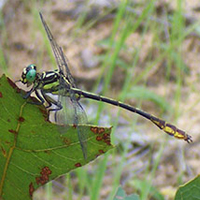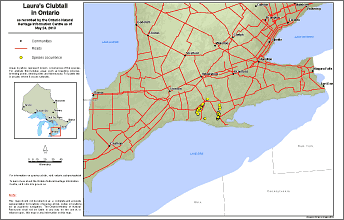Laura’s clubtail
Scientific name: Stylurus laurae

Cover photo credit: Lois Stacey
Status
Endangered
“Endangered” means the species lives in the wild in Ontario but is facing imminent extinction or extirpation.
Date added to the Species at Risk in Ontario List
September 28, 2010
Read the Assessment Report
What it looks like
Laura’s Clubtail is a dragonfly with green eyes and a pale face with one or two dark cross bars.
It has prominent green or yellow stripes on the thorax (the area between the head and the abdomen), and a dark abdomen with a yellow stripe on its back. It is named “clubtail” for a club-like widening at the end of its abdomen.
Laura’s Clubtail is about six centimetres long.
Laura’s Clubtail eggs can take between five and 30 days to hatch. Once hatched, larvae spend two to four years in sand and mud river bottoms. Larvae emerge from the water and molt into adults in June. Adults die in early fall of the same year.
Where it lives
Laura’s Clubtail larvae need shallow, sandy or sandy-muddy bottomed creeks with forested shorelines.
They are sensitive to water quality degradation and are only found in unpolluted waters.
During their adult life stage, they require forest cover beside the creek.
Adults use riffle areas in the stream for foraging and require vegetation along the creek to perch between flights.
Where it’s been found in Ontario
In Ontario, Laura’s Clubtail is only known to occur in two sites in Ontario; along Big Creek and Big Otter Creek in the Tillsonburg and Long Point area near Lake Erie.
This dragonfly may also occur undetected in nearby areas with similar habitats.
Laura’s Clubtail is considered rare in bordering states but is relatively widespread in the southeastern United States.
View a Larger version of this map (PDF)
What threatens it
Since much is still not known about Laura’s Clubtail, direct threats to the Ontario populations have not been identified.
Because Laura’s Clubtail has specific habitat needs and is sensitive to pollution, habitat loss and degradation are potential threats to the species.
Development, agricultural practices, and invasive species – especially round goby – may also degrade Laura’s Clubtail habitat. Many dragonflies are also killed when hit by cars.
Action we are taking
Endangered Species and their habitat are automatically protected
Recovery strategy
A recovery strategy advises the ministry on ways to ensure healthy numbers of the species return to Ontario.
Read the executive summary (December 7, 2011)
Read the recovery strategy (December 7, 2011)
Government response statement
A government response statement outlines the actions the government intends to take or support to help recover the species.
Read the government response statement (September 7, 2012)
Five-year review of progress
A five-year review of progress made toward protecting and recovering a species is required no later than five years after the government response statement for that species is published.
Read the report on progress towards the protection and recovery of six species at risk, including Laura’s Clubtail (2017).
Habitat protection
A habitat regulation defines a species' habitat and many describe features (e.g. a creek, cliff, or beach), geographic boundaries or other unique characteristics.
Read the habitat summary (January 1, 2014)
What you can do
Report a sighting
- The Ministry of Natural Resources tracks species at risk such as the Laura’s Clubtail. Report a sighting of an endangered animal or plant to the Natural Heritage Information Centre. Photographs with specific locations or mapping coordinates are always helpful.
Volunteer
- Volunteer with your local nature club or provincial park to participate in surveys or stewardship work focused on species at risk.
Be a good steward
- Private land owners have a very important role to play in species recovery. If you find Laura’s Clubtail on your land, you may be eligible for stewardship programs that support the protection and recovery of species at risk and their habitats.
- Invasive species such as round goby are a potential threat to Laura’s Clubtail. To learn what you can do to help reduce the threat of invasive species, visit:
www.ontario.ca/invasivespecies
www.invadingspecies.com
www.ontarioinvasiveplants.ca
www.dfo-mpo.gc.ca/science/enviro/ais-eae/index-eng.htm. - The Carolinian forests of southern Ontario support an amazing diversity of plants and wildlife, including many species at risk. Carolinian Canada is working to help recover species at risk and their habitats. For more information, visit:
www.carolinian.org/specieshabitats.htm.
Report illegal activity
- Report any illegal activity related to plants and wildlife to
1-877-TIP-SMNR (847-7667) .
Quick facts
- Laura’s Clubtail was first recorded in Ontario in 1999.
- Laura’s Clubtail is named for Laura Ditzler, a member of the group that first identified the species in 1931.
- Laura’s Clubtail is one of over 170 different kinds of odonates (dragonflies and damselflies) in Ontario.
- Newly emerged adults are at greater risk from predators – frogs, spiders, larger dragonflies and birds – because their exoskeletons have not yet hardened.
- When Laura’s Clubtail are larvae, they start eating single-celled organisms and move on to tadpoles and small fish as they grow larger. Adults feed on small flying insects.
